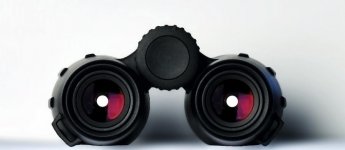In addition to the objective lens aperture, the magnification plays a key role in image brightness. The larger the image on the retina, i.e. the larger the area on which available light is distributed the darker the image.
The key factor is the exit pupil which takes these two effects into consideration. It is the “window” or the “ circular light exit” from which light emerges from the binocular eyepieces. The larger it is the more light that can reach the eye and, therefore, the brighter the image.
The diameter of this exit pupil is calculated on the basis of the following influencing parameters:
8 x 56 binoculars includes an exit pupil with a diameter of 7 mm, 10 x 30 binoculars 3 mm only. If you reach out your arm and hold the binoculars against a light surface and look at the eyepiece, you can clearly see the exit pupils. These are absolutely round with crisp edges and evenly bright on high-quality binoculars.
The exit pupil can be interpreted as the diameter of the luminous flux that exits the binoculars. The eye also plays a vital part in the perceivable image brightness: only the part of the luminous flux that enters the eye can contribute to image brightness. If the user’s pupil is only open 2 to 3 mm during the day, the 7 mm exit pupil of 8 x 56 binoculars cannot be fully utilized. The image through an 8 x 56 model is then no brighter than through 3 x 10 binoculars with a 3 mm exit pupil – assuming all other quality features are identical.

To take full advantage of the emerging light intensity of a binocular the eye pupil has to be at least as large as the exit pupil of the binoculars.
The exit pupil remains the decisive factor in suitability for use at dawn and dusk. In this case, the exit pupil on binoculars should be as large as possible but no less than 4 mm. If the exit pupil is larger than the pupil of the eye, the theoretical brightness of the binoculars is not fully utilized but the eye still has a certain amount of flexibility. Despite shaking hands or binoculars not placed exactly in front of the eyes, you still remain “in the picture” literally. The maximum aperture of the eye pupil largely depends on age.
The pupils of children can open up to more than 8 mm, while they seldom exceeds 4 mm in old age.
While a user’s pupil may only be 2-3mm on a bright day, so they would not be utilizing the full exit pupil of even an 8x32 binocular (4.0mm), it should be remembered that the exit pupils of popular binoculars such as 8x32, 8x42 and 10x42 can still be useful if the day becomes dark due to cloud and rain, or if the user stays out unexpectedly longer, into the twilight of dusk.
The key factor is the exit pupil which takes these two effects into consideration. It is the “window” or the “ circular light exit” from which light emerges from the binocular eyepieces. The larger it is the more light that can reach the eye and, therefore, the brighter the image.
The diameter of this exit pupil is calculated on the basis of the following influencing parameters:
8 x 56 binoculars includes an exit pupil with a diameter of 7 mm, 10 x 30 binoculars 3 mm only. If you reach out your arm and hold the binoculars against a light surface and look at the eyepiece, you can clearly see the exit pupils. These are absolutely round with crisp edges and evenly bright on high-quality binoculars.
The exit pupil can be interpreted as the diameter of the luminous flux that exits the binoculars. The eye also plays a vital part in the perceivable image brightness: only the part of the luminous flux that enters the eye can contribute to image brightness. If the user’s pupil is only open 2 to 3 mm during the day, the 7 mm exit pupil of 8 x 56 binoculars cannot be fully utilized. The image through an 8 x 56 model is then no brighter than through 3 x 10 binoculars with a 3 mm exit pupil – assuming all other quality features are identical.

To take full advantage of the emerging light intensity of a binocular the eye pupil has to be at least as large as the exit pupil of the binoculars.
The exit pupil remains the decisive factor in suitability for use at dawn and dusk. In this case, the exit pupil on binoculars should be as large as possible but no less than 4 mm. If the exit pupil is larger than the pupil of the eye, the theoretical brightness of the binoculars is not fully utilized but the eye still has a certain amount of flexibility. Despite shaking hands or binoculars not placed exactly in front of the eyes, you still remain “in the picture” literally. The maximum aperture of the eye pupil largely depends on age.
The pupils of children can open up to more than 8 mm, while they seldom exceeds 4 mm in old age.
While a user’s pupil may only be 2-3mm on a bright day, so they would not be utilizing the full exit pupil of even an 8x32 binocular (4.0mm), it should be remembered that the exit pupils of popular binoculars such as 8x32, 8x42 and 10x42 can still be useful if the day becomes dark due to cloud and rain, or if the user stays out unexpectedly longer, into the twilight of dusk.







